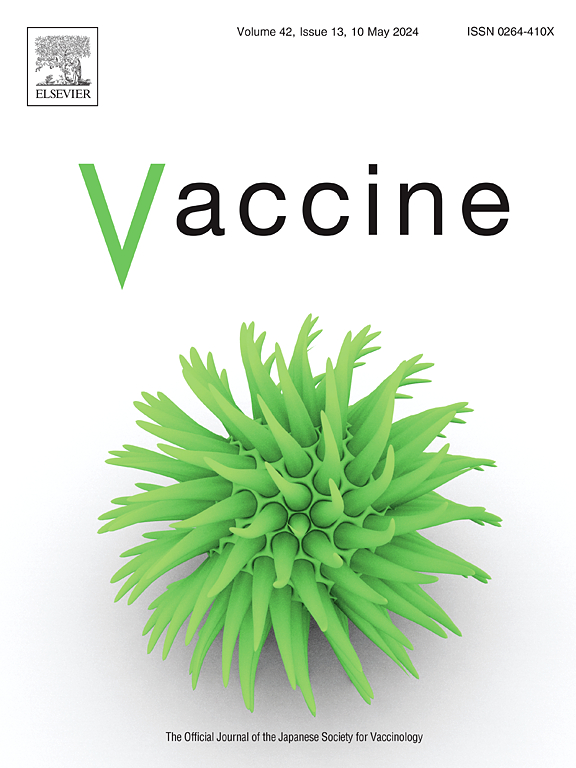Nationwide population-based surveillance of invasive pneumococcal disease in children in Japan (2014–2022): Impact of 13-valent pneumococcal conjugate vaccine and COVID-19 pandemic
IF 4.5
3区 医学
Q2 IMMUNOLOGY
引用次数: 0
Abstract
Background
Nationwide surveillance was conducted in Japan to clarify the status of pediatric invasive pneumococcal diseases (IPD) after introducing a 13-valent pneumococcal conjugate vaccine (PCV13).
Methods
Detailed clinical and epidemiologic information of IPD cases in children aged <15 years was collected from 10 of 47 prefectures in Japan from January 2014 to December 2022. Streptococcus pneumoniae strains isolated from sterile body sites were analyzed including capsular serotypes, multi-locus sequence typing (MLST), and antimicrobial susceptibility testing. The serotype-specific IPD incidence was calculated by imputing the serotypes for missing isolates to serotypes assumed based on the distribution of known serotypes.
Results
During the study period, 1033 IPD cases were reported. The incidence rate of total IPD in patients aged <5 years from 2014 to 2019 declined by 21.3 % compared with the rate from 2011 to 2013 before the introduction of PCV13. Compared with the incidence of total IPD from 2014 to 2019 and from 2020 to 2022, during the COVID-19 pandemic, the incidence of IPD among children aged <5 years declined by 49.7 %. In total, 932 IPD cases were identified as capsular serotypes. Among children aged <5 years, the most frequent serotype was 24F, followed by 15 A, 12F, 15C, 15B, and 10 A. Since 2014, after replacement with PCV13 in 2013, the rate of IPD by PCV13 minus PCV7 serotypes decreased, and non-PCV13 serotypes further increased. The serotype causing IPD in children aged <5 years, with PCV15-unique serotypes and PCV20-unique serotype were 8.6 % and 22.5 %, respectively. In terms of antimicrobial susceptibility, strains resistant to penicillin and cefotaxime decreased, whereas the meropenem non-susceptible strains increased in the post-PCV13 era.
Conclusion
PCV13 introduction and the COVID-19 pandemic have had a significant impact on pediatric IPD in Japan. It is important to continuously monitor the epidemiological characteristics of pediatric IPD after the introduction of PCV20.

日本侵袭性肺炎球菌病全国人群监测(2014-2022):13价肺炎球菌结合疫苗与COVID-19大流行的影响
背景:在引进13价肺炎球菌结合疫苗(PCV13)后,日本开展了全国范围的监测,以明确儿童侵袭性肺炎球菌疾病(IPD)的状况。方法收集2014年1月至2022年12月日本47个县中10个县15岁儿童IPD病例的详细临床和流行病学资料。对无菌体表分离的肺炎链球菌进行荚膜血清型、多位点序列分型(MLST)和药敏试验。通过将缺失分离株的血清型与基于已知血清型分布的假设血清型相关联,计算血清型特异性IPD发病率。结果研究期间共报告IPD 1033例。2014 - 2019年5岁患者总IPD发病率较引入PCV13前的2011 - 2013年下降21.3%。与2014 - 2019年和2020 - 2022年的总IPD发病率相比,2019冠状病毒病大流行期间,5岁儿童IPD发病率下降了49.7%。共有932例IPD被鉴定为荚膜血清型。在5岁儿童中,最常见的血清型是24F,其次是15a、12F、15C、15B和10a。自2014年起,2013年更换PCV13后,PCV13 - PCV7血清型IPD发生率下降,非PCV13血清型IPD发生率进一步上升。导致5岁儿童IPD的血清型,pcv15和pcv20血清型分别为8.6%和22.5%。在药物敏感性方面,pcv13时代后,对青霉素和头孢噻肟耐药的菌株减少,而美罗培南不敏感的菌株增加。结论pcv13的引入和COVID-19大流行对日本儿童IPD产生了重大影响。引入PCV20后,持续监测小儿IPD的流行病学特征十分重要。
本文章由计算机程序翻译,如有差异,请以英文原文为准。
求助全文
约1分钟内获得全文
求助全文
来源期刊

Vaccine
医学-免疫学
CiteScore
8.70
自引率
5.50%
发文量
992
审稿时长
131 days
期刊介绍:
Vaccine is unique in publishing the highest quality science across all disciplines relevant to the field of vaccinology - all original article submissions across basic and clinical research, vaccine manufacturing, history, public policy, behavioral science and ethics, social sciences, safety, and many other related areas are welcomed. The submission categories as given in the Guide for Authors indicate where we receive the most papers. Papers outside these major areas are also welcome and authors are encouraged to contact us with specific questions.
 求助内容:
求助内容: 应助结果提醒方式:
应助结果提醒方式:


